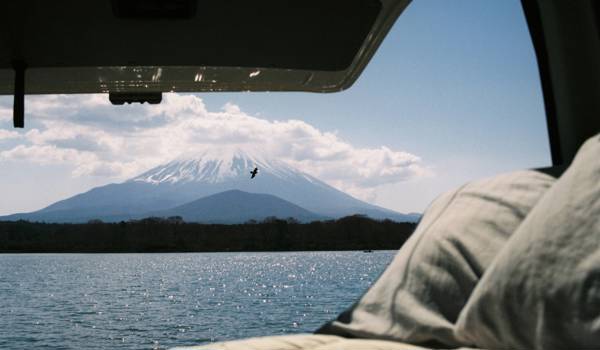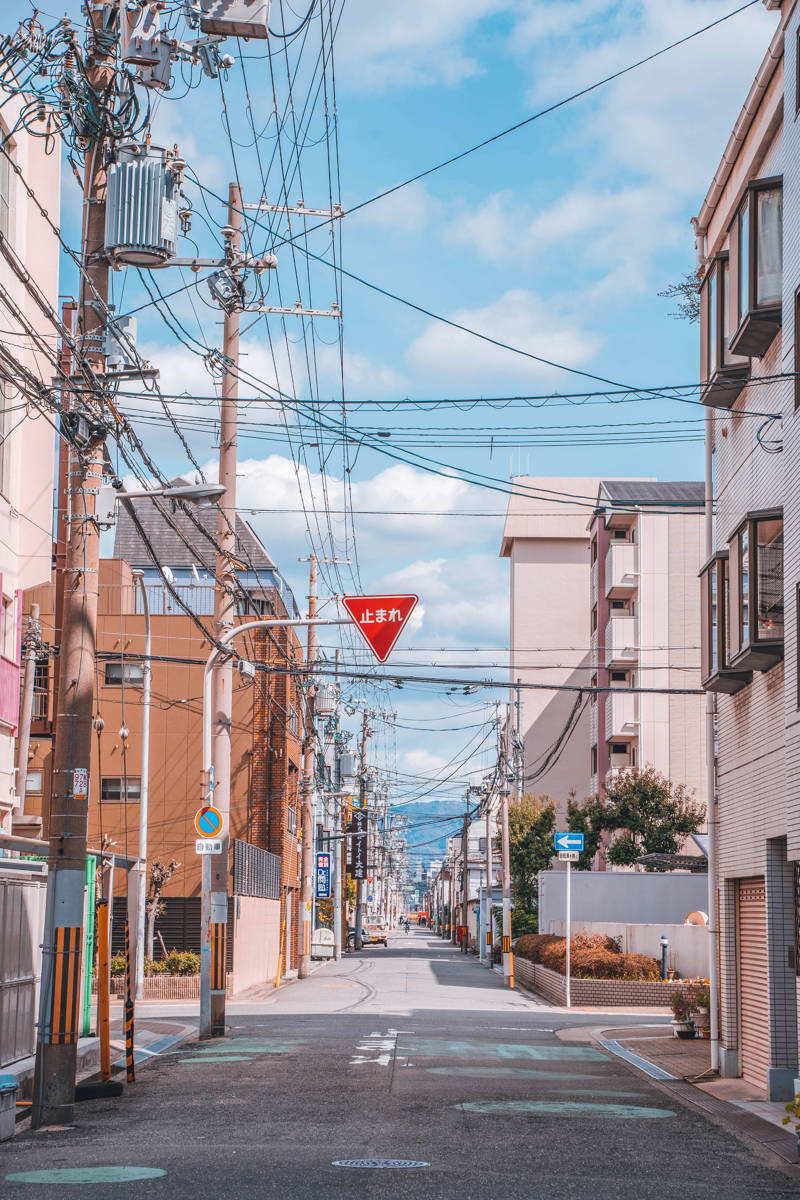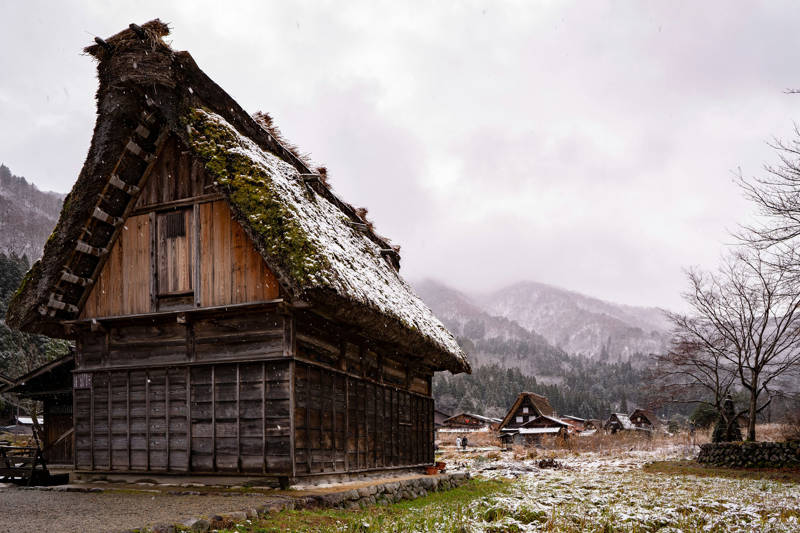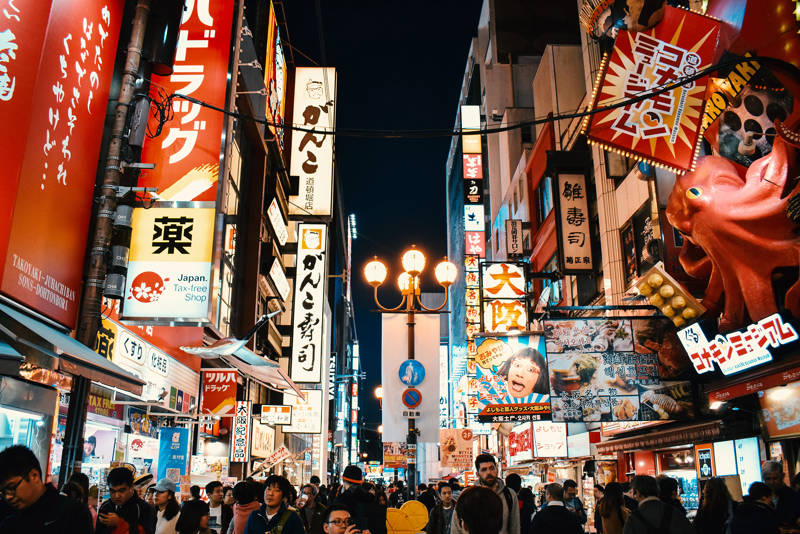Experience Japan like never before: a guide to road tripping in the land of the rising sun
Have you ever dreamed of exploring Japan in a campervan? If so, you're not alone. Japan is a fascinating country that offers a unique blend of ancient culture, modern technology and stunning natural scenery. But how do you plan a road trip in Japan? What are the best places to visit? How do you find campsites, food and hot springs along the way? And what are the rules and etiquette of driving in Japan?
Don't worry, we've got you covered. In this blog, we'll share everything you need to know about road tripping in Japan, from tips and tricks to must-see destinations. We'll also give you two suggested travel routes that will take you to some of the most amazing places in Japan, including Tokyo, Kyoto, Osaka, Nagano, Kanazawa, Hakone and Mt. Fuji.
Are you ready to experience Japan like never before? Then read on and get inspired for your next adventure!

Renting your own campervan is one of the most affordable ways to travel through Japan, as you combine transport and accommodation into one. But it's also a great way to get off the beaten path. With so much freedom, the choice of where to go and what to visit is almost overwhelming.
That's why we're helping you with two great possible route options for your trip. If you're unsure whether a campervan is the right option for you, check out our Kuga campervans. These vehicles are compact but spacious, fully equipped and oh so practical, providing you with everything you need. Still left with questions? Don't be shy, we love to help!
Good to know before your Japanese road trip
So, first things first. There are a few things to keep in mind before flying off to the land of sushi and sake. First of all, you'll need to obtain an International Driver's Licence, which is quite important if you want to be able to drive there. You can apply for one in your home country before your trip, but be sure to do it in time.
Next up, you'll need to rent a campervan. This can be a little more tricky, as it's kind of a niche travel style, and as with most things in Japan there can be a language barrier, even when it comes to tourism. Lucky for you, you can also arrange your campervan through KILROY. It's smooth, easy and you'll be sure to get the best value.
It's important to pack lightly since most campervans in Japan don't have a lot of storage space. Pack only the essentials you need, and avoid using hard suitcases as they take up more room. Instead, consider using duffle bags, backpacks, and tote bags to store your belongings. If you rent a campervan through KILROY, you can rent all the utensils and things like sheets and blankets for a small fee, making it so much easier to pack light.

Michi-no-Eki - the Japanese roadside stations you didn't know you needed
Japan has a vast network of Michi-no-Eki, or roadside stations, which are government-designated rest stops that offer far more than the service stations you may be used to. These pit stops will be indispensable during your road trip, offering free parking, immaculately maintained toilet facilities, vending machines serving hot and cold drinks, free Wi-Fi, and even shower facilities in some stations. Many also provide a place to charge your electronic devices, ATM services, and changing facilities for infants.
Enthusiastic guides will supply you with local information on each and every location you may want to visit. They will also be more than eager to help you get back on track if you need directions, as well as pointing the way to the most popular local sites of interest.
Important to remember though, is that most Michi-no-Eki close at night. The toilets are available 24/7 though, but you are not allowed to camp at the Michi-no-Ekis!
Thinking you will have to skip on the lovely onsens (Japanese hot spring baths) when doing a campervan trip? Luckily, the answer is no! There are several Michi-no-Eki locations with their own included hot springs. The following ones are worth a visit:
- Kusatsu Onsen Michi-no-eki: Located in Gunma Prefecture, this Michi-no-eki is situated near the famous Kusatsu Onsen hot spring resort.
- Yunokawa Onsen Michi-no-eki: Located in Hokkaido, this Michi-no-eki is situated near the Yunokawa Onsen hot spring resort.
- Takayu Onsen Michi-no-eki: Located in Fukushima Prefecture, this Michi-no-eki is situated near the Takayu Onsen hot spring resort.

Where to sleep on your Japanese road trip - the best campsites
Japan is home to over 3,000 public and private campsites that offer a range of amenities and facilities. We've highlighted a couple in our two suggested travel routes, but there are campsites in basically every corner of Honshu (Japan's main island). Some of the best campsites to stay at during a campervan road trip in Japan are:
- Azuri Beach in Mie Prefecture: This beachside campsite offers several simple camping grounds alongside the beach with auto-camping sections, camping houses and bungalows. It’s perfect for swimming, fishing and kayaking.
- Lake Tazawa in Akita: This scenic caldera lake has been voted one of Japan’s 100 most scenic spots. It’s worth trekking and cycling, or if you’re travelling with a campervan, make sure to drive along the lakeside before you set up camp.
- Kamikochi in Nagano: This campsite is located in the Northern Japanese Alps and is surrounded by beautiful mountains and forests. It’s perfect for hiking and enjoying the natural beauty of Japan.
To easily find more campsites in Japan, we recommend using the Michi Japan Road Trip app. It's a great app to find campsites, Michi-no-Eki's and hot springs along the way. You don't need the internet to use the app, and can even use it to navigate the country.
Most of Japan’s campsites are free, but some charge a small fee. If you go camping, you can usually find toilets and sinks there. Since Japan has lots of hot springs, there are often campsites near them. If your campsite doesn't have one, and there aren't any shower facilities, you can often find a hot spring nearby. During the high season and weekends we recommend booking your spot at the campsites in advance to avoid disappointment and last-minute changes of plans.

Japanese traffic rules to remember on your trip
It's also important to understand that driving is done on the left side of the road in Japan, just like in the UK.
While you maybe would expect some strange or quirky road signs in Japan, in reality most Japanese traffic signs adhere to international standards, so they're easy to understand if you're a foreigner. However, the one huge difference is the stop sign. In Japan, the stop sign is a red triangle with the Kanji translation of ‘stop’ right inside the sign, like in the picture below. And while you can't read the words, all the rest of the signs are pretty much common sense.
There are a few rules to keep in mind though, when driving in Japan. Nothing big, but you want to keep to the local driving etiquette to avoid tickets and problems in general:
- No honking: Honking is considered rude in Japan and is really only used in absolute emergency situations.
- No eating or drinking while driving: It is illegal to eat or drink while driving in Japan, so make sure to take breaks in between drives. Luckily there are so many interesting places to make a stop, so this won't be a problem.
- No driving with high heels: It is illegal to drive with high heels in Japan, as they can get stuck between pedals.
- No driving with headphones: It is illegal to drive with headphones on in Japan, as it can be a distraction.

Finding food en-route - our favourite dishes
Japan is a paradise for food lovers, and for many it's one of the main reasons to travel there. If you're travelling by campervan you've got the option to cook food yourself, if you want to keep things low budget. But if there is one thing we wouldn't save money on - it's food. Even on a limited budget you will never run out of options to satisfy your hunger, and you really don't want to miss out on all the great Sushi, Yakitori (grilled meat skewers), Takoyaki (octopus balls) and Okonomiyaki (a strange but amazing savory omelette/pancake crossover filled with noodles and veggies).
Here are some tips for finding food on the go in Japan with your campervan:

Suggested travel route 1: Tokyo - Nagano - Kanazawa - Takayama/Japanese Alps - Mt. Fuji - Tokyo
Now, let's look at some possible travel routes. We've cooked up two great itineraries for you, and this is the first one. You start your journey in Tokyo, Japan’s bustling capital city. In Tokyo, there is so much to see and do it's literally overwhelming. Each neighborhood is quite different, but we suggest you to at least go and see the Tsukiji Fish Market and the Senso-ji Temple in Asakusa, one of Tokyo’s oldest and most famous temples. For a bit of piece and quiet (if you stay away from the main trails that is), we suggest the Meiji Shrine in Shibuya, a serene and peaceful shrine surrounded by a lush forest. Another great option is the Shinjuku Gyoen National Garden, a beautiful park in the heart of Tokyo. All of this should of course be complimented by some shopping and plenty of stops for food and snacks. The pick-up location for your KILROY campervan is also located in Tokyo, so we suggest spending a few days in the city before starting your rental. You won't need the camper in this metropolis anyway!
On your first travel day, drive to Chichibu (slightly less than 2 hours driving) and visit the Chichibu Shrine, a beautiful shrine located on a hilltop with stunning views of the surrounding mountains. Next, you visit the Chichibu Muse Park, a beautiful park with a variety of flowers and plants. It's a great little overnight stop on the way to your next destination: Nagano! In Nagano we recommend the Zenko-ji Temple, one of Japan’s oldest and most important temples. Also worth visiting (and much easier to reach with a campervan) is the Togakushi Shrine, a beautiful shrine located in the mountains. After a long day out and about, you'll love a relaxing moment at one of Nagano’s many hot springs. There is a lot to see and do in the Nagano area (you've probably heard of the famous Snow Monkeys occupying the hot springs), so we recommend at least a couple of days here.
When you're ready to leave Nagano behind, it's time to head towards the coastal town of Kanazawa and visit the Kenroku-en Garden, one of Japan’s most beautiful gardens. Next up is the Kanazawa Castle, a beautiful castle located in the heart of the city. In the evening we'd like to suggest going to the Higashi Chaya District, a beautifully preserved geisha district, and visit one of the many teahouses. If you happen to visit in the warmer months, the nearby Noto peninsula has big sandy beaches which are great for some relaxation. While you are allowed to drive on many of the beaches, camping is prohibited.
From the coast of Honshu, it's time to continue and explore the Japanese Alps. While the entire region is drop-dead gorgeous, we think the Kamikochi Valley, a stunning valley with crystal-clear water and breathtaking views, is an absolute must. Another one of our favourites is Hakusan National Park, with some of the best views in the Japanese Alps. On the way, do stop by the Shirakawa-go Village, which is a UNESCO World Heritage Site known for its traditional thatched-roof houses as seen in the picture below. Staying a night (or two) in Takayama as a base to explore the region and its ancient villages is probably the best way to go - check out the Hidatakayama camping ground!
Next on the program is Mt. Fuji - and this one needs no introduction, right? While driving there, gaze at the great views - plan in some extra time for the many photo stops you're going to do. There's also plenty of possibilities for hikes and if you have the time for it Mt. Amagoi is an absolute stunner. Once you arrive in the Mt. Fuji area you'll probably be pretty tired, but if you've got the energy left, the area around lake Kawaguchi is worth exploring. It's part of the Fuji Five Lakes, a group of five beautiful lakes at the base of Mt. Fuji. From Fuji, it's time to head back to Tokyo, to hand in the campervan and spend your last day(s) exploring the city at your leisure until you'll eventually fly home.

Suggested travel route 2: Tokyo - Kyoto - Kobe - Osaka - Nagoya - Hakone - Tokyo
Just like the first travel suggestion, you start in Tokyo. To be honest, we could stay here for weeks without getting bored, but we'll let you decide how many days you want to stay here. At least a couple days at either the beginning or end of your trip is a must. When you're ready to start your road trip, it's time to collect your campervan and get going!
We'll leave any stops in between up to you, but the idea is that sooner or later you'll end up in Kyoto. Here you can see many, many temples, of which the Kinkaku-ji Temple (also known as the Golden Pavilion) is probably the most impressive. Next, visit the Nijo Castle, a UNESCO World Heritage Site and take it chill exploring the Gion District, Kyoto’s historical neighborhood. If you want to go a little more of the beaten path, jump in your campervan and drive up along the Kibune river, just north of Kyoto. There are plenty of old shrines a long the way, some even eerie and deserted, but the mysterious forest setting all of them have is simply beautiful.
Once you've seen all there is to see (or your time is running out), make your way to Kobe. Not just to taste the incredibly smooth Kobe beef (sorry, vegetarians!), but it's a charming place in its own right. Visit the Kobe Nunobiki Herb Garden, a beautiful garden with a variety of flowers and plants and walk through the Kitano-cho District, a beautifully preserved district with a variety of Western-style houses. When it starts to get dark you'll love visiting the Kobe Harborland, a waterfront area with a variety of bars and restaurants.
Depending on how much time you've got on your hands, you could head down to the historically interesting Hiroshima (don't worry, even if you're not into history there is plenty to see down south). If you have less days to spare, it's Osaka that's up next. Here you can see Osaka Castle, one of Japan’s most famous castles. Make sure to visit the Dotonbori area, a bustling entertainment district with a variety of shops and restaurants. that's especially alive at night. Osaka is known as Japan's (street)food capital, so make sure to try all that you can.
After Osaka, slowly head back into the direction of Tokyo. If you haven't visited Nara when in Kyoto or Osaka, that is definitely a stop you'll want to make, before ending your day in Nagoya. After a good night of sleep in your campervan. You can visit yet another castle, and the Atsuta Shrine, one of Japan’s most important shrines. If you're after a little relaxation, Nagoya also offers plenty of hot springs. From Nagoya you'll drive to Hakone, on the southern coast south of Tokyo. Here you can do some fantastic hikes, and since Hakone is a typical hot spring town, a nice onsen will be waiting for you in the evening. If you're lucky, Hakone will also present you with a magnificent view of Mt Fuji, but if you want to see the mountain up close, a detour via the Fuji Five lakes area is recommended.
It's not a long drive from Hakone or Fuji to Tokyo, where you'll spend your remaining time exploring the city. We've already described many things you can do here, but it might be a good idea to at least visit the main neighbourhoods at least once, and take a good look around for some quirky souvenirs. Remember to stock up on Japanese snacks for the flight home!


